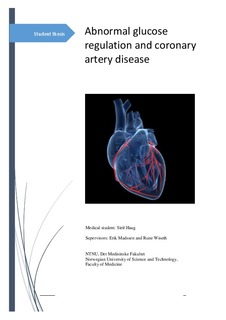| dc.description.abstract | Abnormal glucose regulation describes a condition with disturbed glucometabolic status. Patients with this abnormality have an increased risk of developing both micro- and macrovascular complications. Patients with abnormal glucose regulation composite a large percentage of patients undergoing coronary revascularization. These patients have a poorer prognosis following coronary revascularization compared to normoglycaemic patients. Thus, screening for undiagnosed diabetes mellitus is recommended in patients with established coronary artery disease. Currently there are three methods available to identify abnormal glucose regulation; fasting plasma glucose, an oral glucose tolerance test and glycated haemoglobin (HbA1c). The sensitivity of these methods in identifying abnormal glucose regulation in patients with concomitant coronary artery disease is essential. We therefore aimed to validate the diagnostic strength of in-hospital HbA1c in detection of abnormal glucose tolerance in patients undergoing PCI with an oral glucose tolerance test 4-6 weeks after index PCI as gold standard. Our study included eighty-six patients from the Gluko-Norstent study, which is a trial designed to analyse the association between glucometabolic disturbances and the long-term outcome after PCI with stent implantation. A comprehensive review of the literature was performed as part of this project. When using the recommended cut off value of HbA1c of 6.5 % we found that abnormal glucose regulation was underdiagnosed with in-hospital HbA1c when compared to an oral glucose tolerance test. The “high risk” HbA1c range of 5.7-6.4 % seemed to overestimate the number of patients with impaired glucose tolerance based on the oral glucose tolerance test. The combination of in-hospital fasting plasma glucose and HbA1c was found to add diagnostic strength in identifying abnormal glucose tolerance in patients with established coronary artery disease. | nb_NO |
